
Search
The Renewable Energy site for Do-It-Yourselfers
2nd Test of
Reference Solar Air Heating Collector 10/12/04
| This is a several hour test of the
reference collector in full sun, winter conditions. The test was
done on a good sun day with an outside temperature around 21F.
The collector inlet and outlet temperatures were logged along with
the ambient temperature and the sun intensity for about 5 hours.
The collector flow rate was also checked at a couple points during the
test.
The heat output of the collector is calculated from the above, and a
rough estimate of efficiency is also made.
In a nutshell, I think the collector design is performing well.
NOTE: This was the first collector built, and none of the tests below
show comparisons to the other collector designs -- see the links on the
other collectors for the comparative performance.
Back to the Solar Air Heating Collector test
program home.. |
|
Setup
Pictures below show the setup. A few small changes were made from
yesterdays setup to make it easier to make the measurements and keep things
stable.
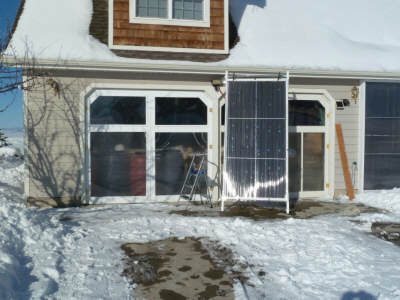
Collector location. |
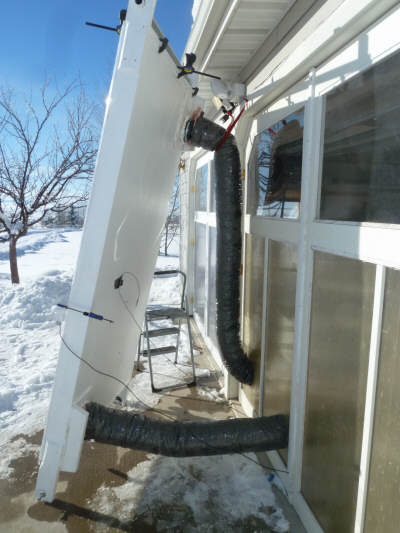
Inlet and outlet ducting |
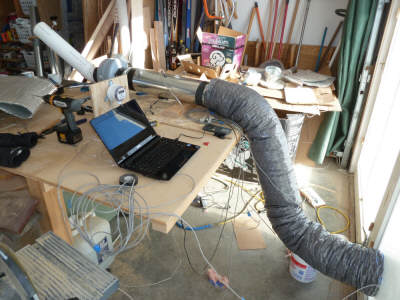
Revised outlet ducting.
The big yellow bag connects to the 4 inch PVC exit duct
from the blower for flowrate test. |
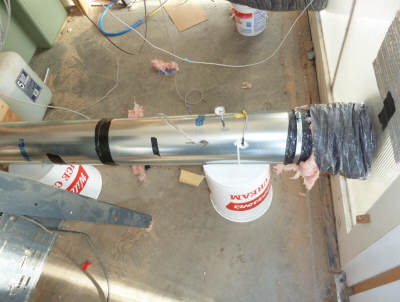
Inlet duct routing. |
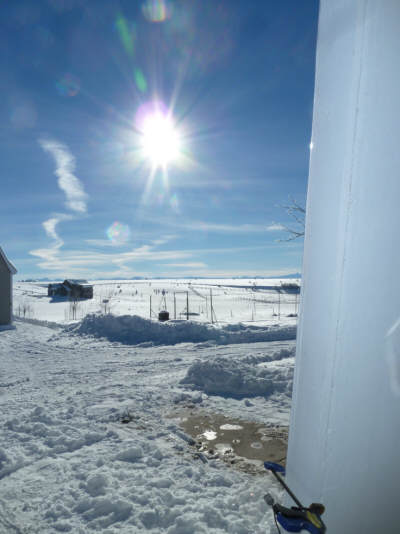
Sun conditions. Mostly very good with occasional
thin clouds in front of sun. |
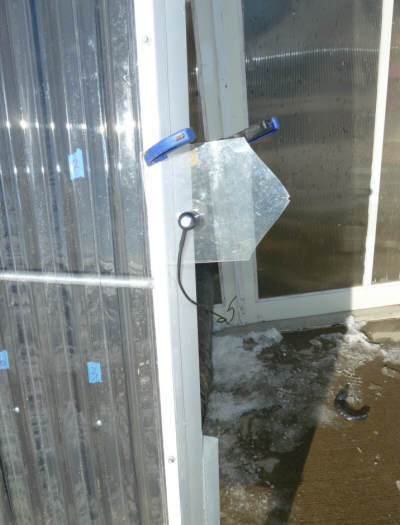
The Apogee Pyranometer mounting -- in same plane
as the collector. |
Results
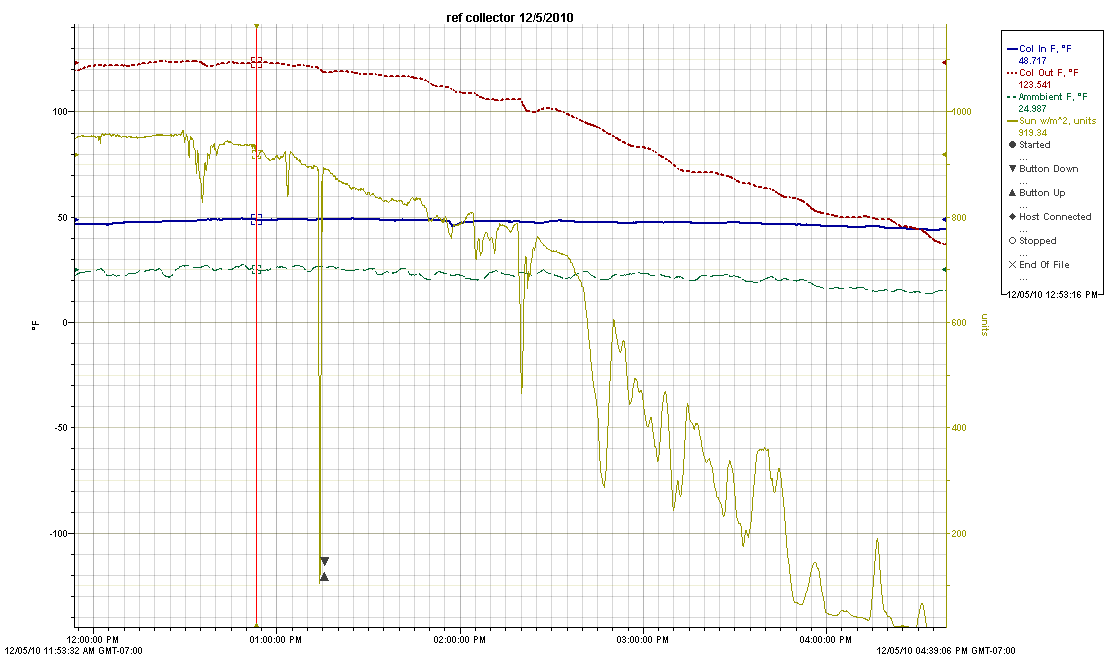
This is the plot of temperatures and sun
intensity starting around noon and going through about 4 pm.
For the time marked by the vertical
line on the plot above:
Collector outlet temp = 123.5 F
Collector inlet temp = 48.7 F
Temperature rise = 74.8 F
Flow rate = 80 cfm
(about 2.5 cfm per sqft of collector area)
Sun intensity on the collector
surface was 919 watt/sm
Ambient temperature was 25 F
Pressure drop over the collector
was 0.415 inches of water
Air density is calculated as
0.0611 lbs/cf based on 5000 ft altitude and 78F average col temp (see note
below)
The flow rate was estimated based on
a 42 second fill time for the big yellow bag (56 cf), which 80 cfm.
A check on this was that the Kestrel
wind meter showed an exit velocity from the 4 inch exit duct of 940 fpm, which
gives (940 fpm)(0.087 sf) = 81.8 cf.
I still need to do a more careful
calculation of the bag volume, so this may change a little.
Collector inlet and outlet
temperatures were measured with thermistors in the inlet and outlet ducts.
The thermistors were placed in the center of the ducts. In the case of the
inlet duct, there is about 4 ft of duct between the thermistor location and the
actual collector inlet. In the case of the outlet duct, there is about a
10 ft length of duct between the thermistor location and the actual collector
outlet.
The thermistors are from Onset
Computer, and are (as I recall) said to be within 1/4 F over their normal range.
Ambient temperature was measured in a
shaded spot about 2 inches behind the collector and about 4 ft off the ground.
sun intensity was measured with an
Apogee pyranometer that was mounted in the same plane as the collector glazing.
While the sun conditions looked quite good, base on past experience I would have
expected readings over 1000 watts/sm given the clear looking conditions.
Just shows its hard to judge the sun intensity visually.
Heat Output
The heat output for the point marked
on the plot above at about 12:53 pm is:
Heat Out = (80 cfm)(0.061
lb/ft^3)(123.5 F - 48.7 F)(0.24 BTU/lb-F) = 87.6 BTU/min = 5256 BTU/hr
The 75F temperature rise with 2.5 cfm
per sqft airflow through the collector under winter conditions with a single
glazed collector seems quite in line with what a good air collector should be
doing to me.
Efficiency
This is a very rough estimate of
efficiency for the point marked on the plot above.
Efficiency = (Heat Energy out) /
(Solar energy in)
Heat Energy Out is the 5256 BTU/hr
calculated above
Solar energy in is 919 watts/sq meter
= 291 BTU/hr-sf.
Efficiency = (5256 BTU/hr) / (291
BTU/sf)(32 sf) = 56.4%
This seems fine to me -- better than
I would have expected for this type of calculator under winter conditions.
Other Bits
Measured the stagnation temperature
before the test started at 190 F. This was with a little bit of air
thermosyphoning through the collector -- you could see a little vapor coming out
of what is normally the inlet duct (lower duct).
The dip in sun intensity at about
1:15 (where the double triangles are) is me cleaning off the outside of the
glazing with windex -- it still had some shop dust on it. Did not seem to
make much difference. Inside of glazing was cleaned before installing.
Background on Heat Output
Calculation
The heat output depends on the weight
flow of through the collector and the temperature rise from inlet to outlet.
Heat Out = (Flow Rate) (Air Density)
(Temperature Rise) (Specific Heat of Air)
Flow Rate is the volumetric flow
rate in cubic ft/minute (cfm)
Air Density is the density of the
air in pounds per cubic foot
Temperature Rise is the outlet
temperature - inlet temperature in degrees F
Specific Heat of Air is the
energy in BTu's required to raise the temperature of 1 lb of air 1 degree F
(0.24 BTU/lb-F for air)
I measured the volume flow, and since
density of the air (the weight per cubic foot) depends on the air temperature
and pressure (altitude), I use this calculator to estimate the density of the
air based on our altitude (5000 ft above sea level) and the average temperature
of the collector air.
Air Density Calculator:
http://www.denysschen.com/catalogue/density.asp
For a collector temperature of (110F
+ 47F)/2 = 78F, and an altitude of 5000 ft, the density of air is 0.0611
lb/ft^3 -- this compares to 0.073 lb/ft^3 for 78F at sea
level.
I've not taken into account our
actual barometric pressure -- will have to look into that.
This is an added set of data for
12/6/10
This was a day that started with
pretty good sun, but then developed into an overcast.
I left the collector running through
the whole cloudy day just to see how it would do at much lower sun levels.
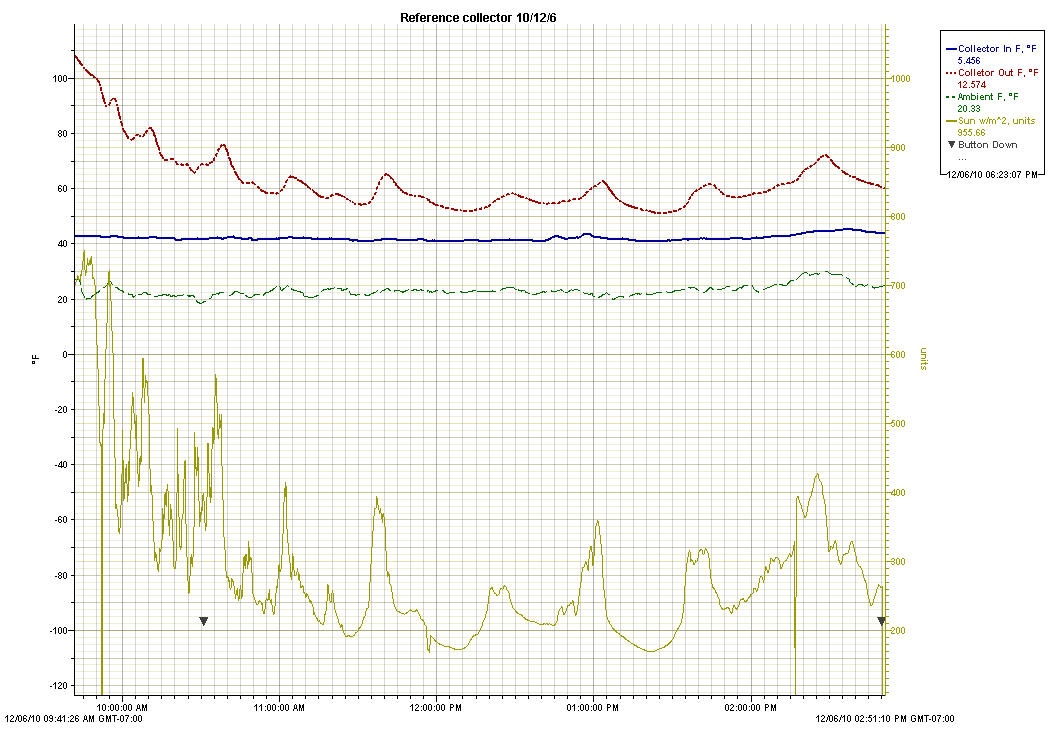
In the early morning, with the sun up
at 700 watt/m^2, the collector was heating from about 42 F up to 108 F for a 66
F rise with 73 cfm flow rate, and with an ambient temperature of about 20F.
The plot shows what happens as the
clouds come in and sun level drop to 200 watts/m^2 and even less.
The collector hangs in there
producing some heat even at sun levels as low as 200 watts/m^2.
Part of the reason the collector was
able to keep producing heat even at sun levels of 200 watts/sm is that the
collector inlet temperature was relatively low -- ie the shop was not that warm
-- but still, its pretty interesting that its able to produce some heat at these
low sun levels.
This is an Added Set for 12/7/2010
Good sun until about noon, then
highly variable sun for the rest of the day.
Weather:
No wind
About 32 F ambient
Good sun early with clouds coming
in and out in the afternoon.
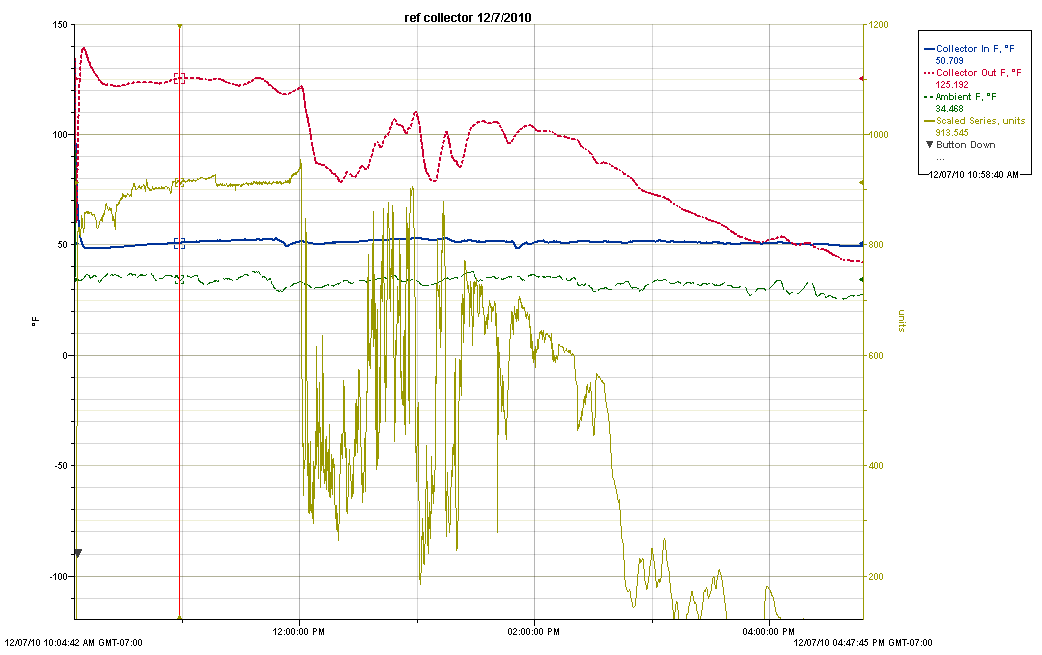
Yellow bag fill time of 49 seconds,
implying about 67 cfm.
Kestrel wind meter reads near 820 fpm
at the exit of the 4 inch duct, implying 71 cfm.
Static pressure drops over the
collector of about 0.41 inches of water.
The 75F temperature rise with 51 F
inlet temperature, 913 watt/m^2 sun, and 70 cfm seems good to me.
Note that at 4:30pm, the collector
started to cool the room instead of heat it.
Gary December 5, 2010, December 6,
2010



